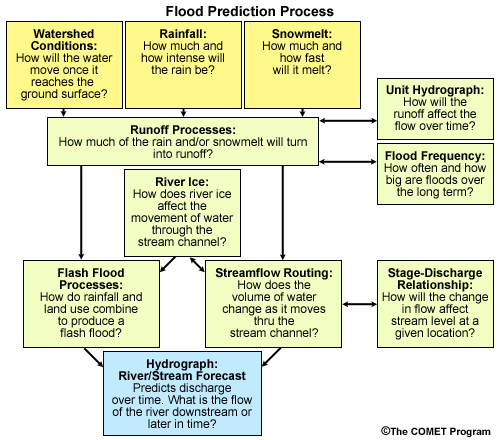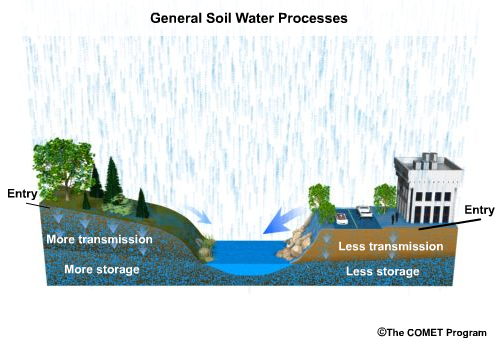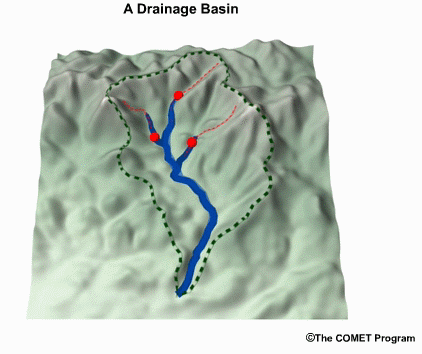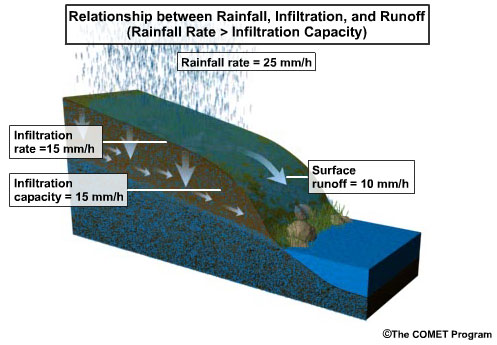< Back to Print Version Table of Contents <

An accurate estimate of runoff from rain and snowmelt is one of the most important elements of the flood forecast process.
In this section we will define runoff and introduce some important terms used when discussing the rainfall-runoff process. We will discuss the runoff from both rain and snowmelt and how it relates to the overall hydrologic forecasting process.
In this section you will learn to:
- Define rainfall runoff
- Identify the general movement of water both on the surface and in the ground
- Recognize the different terms associated with groundwater and runoff
- Understand the relationship between precipitation/snowmelt rate and infiltration
Topics in this section include:
Runoff Defined
Role in Flood Prediction Process
General Soil Water Processes
General Runoff Terms
Infiltration Terms
Review Questions
Choose a section above by clicking it, scroll down, or read on to continue the module.
< Back to Print Version Table of Contents<
Runoff Defined

Runoff is often defined as the portion of rainfall, snowmelt, and/or irrigation water that runs over the soil surface toward the stream rather than infiltrating into the soil. It is sometimes called surface runoff.
For some purposes however, the definition of runoff also includes water which makes its way relatively quickly to the stream channel just below the surface. This is sometimes called interflow or subsurface stormflow, and together with surface runoff makes up the volume of water that hydrologists generally refer to as runoff.
Role in Flood Prediction Process

The main reason for studying the runoff process is to get an estimate of the amount of water that makes its way quickly to the stream channel. Runoff is the most important component of flood prediction and can consist of either rainwater or water from melting ice and snow. Watershed conditions will impact the proportion of rain or snow that becomes runoff. Once we know the amount of water expected to become runoff, other tools such as the unit hydrograph can assist us with estimating the resulting discharge in the stream.
General Soil Water Processes

There are three physical processes for the movement of soil water: entry, transmission, and storage. Entry, also known as infiltration, occurs at the water-ground surface boundary. Transmission is the vertical and horizontal percolation that can occur throughout the entire depth of the soil layer. Storage can occur throughout the soil profile and is manifested as increased soil moisture.
Environmental conditions that affect these three processes are broadly broken down into two major categories: natural influences and human activity influences. Natural processes can have a variety of influences, but human activity typically results in less water entering the soil profile and thus more runoff at the ground surface.
General Runoff Terms

Click the image above to view animation.
There are a number of terms commonly used to describe runoff processes. Let’s briefly introduce some of these terms which will be covered in more detail in later sections of this module.
Basin, drainage basin, or watershed, are all terms used to describe the area contributing to the runoff. The runoff in a basin generally begins at the drainage divide that marks the perimeter of the basin. All runoff within a basin drains to a single point at the outlet of that basin.

Click the image above to view animation.
Baseflow is the long-term supply of water that keeps at least some water in the stream even during extended dry periods. Baseflow comes from water that percolated down into deep storage.
Infiltration is the downward movement of water through the soil surface. While it is often used interchangeably with percolation, percolation actually refers to movement of water within soil, and infiltration specifically refers just to the process of water entering a soil surface.
Surface runoff is the movement of water across the soil surface toward the stream channel.
Interflow is the relatively rapid movement of water below the soil surface toward the stream channel, typically within 72 hours of when water infiltrates the surface. This process is more likely in areas with deep soil.
Runoff, sometimes called quick response runoff,
can refer to surface runoff only, but sometimes it is the combination of surface
runoff plus interflow. Thus, it typically represents the movement of water
to the stream channel that is not part of baseflow.
Infiltration Terms

Click the image above to view animation.
Infiltration rate is the amount of water able to enter the soil in a specified time period. It is expressed as depth per time; for example, 10 millimeters per hour.
Infiltration capacity is the upper limit of infiltration rate. It includes surface infiltration and percolation and is expressed in depth per time; for example, 15 millimeters per hour.
If precipitation rate is less than or equal to infiltration capacity, no surface runoff occurs.

Click the image above to view animation.
If precipitation rate is greater than infiltration capacity, surface runoff occurs.
Surface runoff equals rainfall or snowmelt rate minus infiltration capacity.
For example, if our rainfall rate increases to 25 millimeters per hour but the infiltration capacity remains at 15 millimeters per hour, then the rainfall rate is 10 millimeters per hour greater than the infiltration capacity. The 10 millimeters per hour that does not infiltrate becomes surface runoff.
Review Questions:
1. Simply stated, runoff is the portion of rain, snowmelt, or irrigation water that makes its way quickly to the stream _____.
(Choose the best answer.)
a) over impermeable surfaces only
b) along or beneath the surface
c) through the soil
d) as enhanced baseflow
2. When the rainfall rate is equal to the infiltration capacity, _____.
(Choose all that apply.)
a) water can infiltrate and possibly contribute to interflow
b) the soil will never reach saturation unless it rains harder
c) no more water will be able to infiltrate
d) any further increase in rainfall intensity will cause surface runoff
Review Question Feedback
1. Simply stated, runoff is the portion of rain, snowmelt, or irrigation water that makes its way quickly to the stream _____.
(Choose the best answer.)
The correct answer is b) along or beneath the surface.
2. When the rainfall rate is equal to the infiltration capacity, _____.
(Choose all that apply.)
The correct answers are:
a) water can infiltrate and possibly contribute to interflow, and
d) any further increase in rainfall intensity will cause surface runoff
End of Section One: Overview Of Runoff







